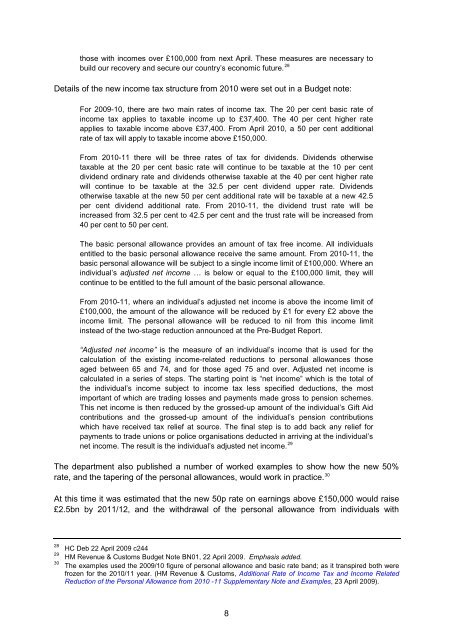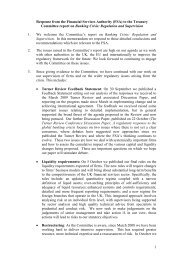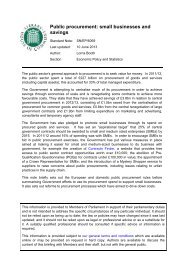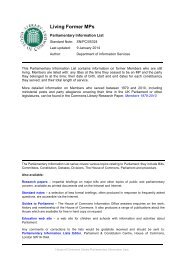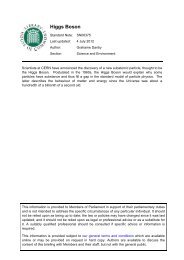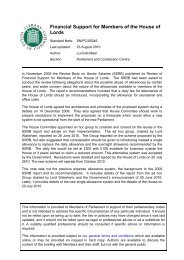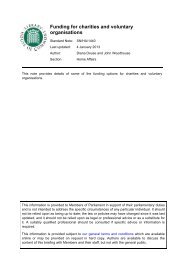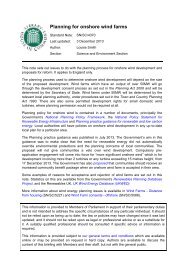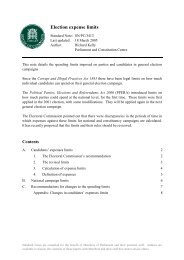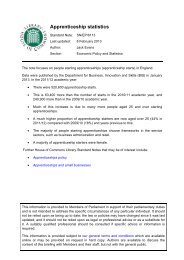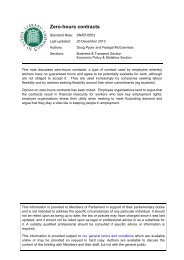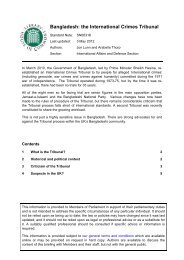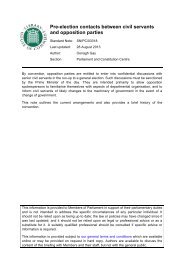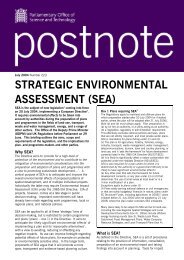Income tax: the additional 50p rate ( PDF, 41 pages ... - Parliament
Income tax: the additional 50p rate ( PDF, 41 pages ... - Parliament
Income tax: the additional 50p rate ( PDF, 41 pages ... - Parliament
Create successful ePaper yourself
Turn your PDF publications into a flip-book with our unique Google optimized e-Paper software.
those with incomes over £100,000 from next April. These measures are necessary to<br />
build our recovery and secure our country’s economic future. 28<br />
Details of <strong>the</strong> new income <strong>tax</strong> structure from 2010 were set out in a Budget note:<br />
For 2009-10, <strong>the</strong>re are two main <strong>rate</strong>s of income <strong>tax</strong>. The 20 per cent basic <strong>rate</strong> of<br />
income <strong>tax</strong> applies to <strong>tax</strong>able income up to £37,400. The 40 per cent higher <strong>rate</strong><br />
applies to <strong>tax</strong>able income above £37,400. From April 2010, a 50 per cent <strong>additional</strong><br />
<strong>rate</strong> of <strong>tax</strong> will apply to <strong>tax</strong>able income above £150,000.<br />
From 2010-11 <strong>the</strong>re will be three <strong>rate</strong>s of <strong>tax</strong> for dividends. Dividends o<strong>the</strong>rwise<br />
<strong>tax</strong>able at <strong>the</strong> 20 per cent basic <strong>rate</strong> will continue to be <strong>tax</strong>able at <strong>the</strong> 10 per cent<br />
dividend ordinary <strong>rate</strong> and dividends o<strong>the</strong>rwise <strong>tax</strong>able at <strong>the</strong> 40 per cent higher <strong>rate</strong><br />
will continue to be <strong>tax</strong>able at <strong>the</strong> 32.5 per cent dividend upper <strong>rate</strong>. Dividends<br />
o<strong>the</strong>rwise <strong>tax</strong>able at <strong>the</strong> new 50 per cent <strong>additional</strong> <strong>rate</strong> will be <strong>tax</strong>able at a new 42.5<br />
per cent dividend <strong>additional</strong> <strong>rate</strong>. From 2010-11, <strong>the</strong> dividend trust <strong>rate</strong> will be<br />
increased from 32.5 per cent to 42.5 per cent and <strong>the</strong> trust <strong>rate</strong> will be increased from<br />
40 per cent to 50 per cent.<br />
The basic personal allowance provides an amount of <strong>tax</strong> free income. All individuals<br />
entitled to <strong>the</strong> basic personal allowance receive <strong>the</strong> same amount. From 2010-11, <strong>the</strong><br />
basic personal allowance will be subject to a single income limit of £100,000. Where an<br />
individual’s adjusted net income … is below or equal to <strong>the</strong> £100,000 limit, <strong>the</strong>y will<br />
continue to be entitled to <strong>the</strong> full amount of <strong>the</strong> basic personal allowance.<br />
From 2010-11, where an individual’s adjusted net income is above <strong>the</strong> income limit of<br />
£100,000, <strong>the</strong> amount of <strong>the</strong> allowance will be reduced by £1 for every £2 above <strong>the</strong><br />
income limit. The personal allowance will be reduced to nil from this income limit<br />
instead of <strong>the</strong> two-stage reduction announced at <strong>the</strong> Pre-Budget Report.<br />
“Adjusted net income” is <strong>the</strong> measure of an individual’s income that is used for <strong>the</strong><br />
calculation of <strong>the</strong> existing income-related reductions to personal allowances those<br />
aged between 65 and 74, and for those aged 75 and over. Adjusted net income is<br />
calculated in a series of steps. The starting point is “net income” which is <strong>the</strong> total of<br />
<strong>the</strong> individual’s income subject to income <strong>tax</strong> less specified deductions, <strong>the</strong> most<br />
important of which are trading losses and payments made gross to pension schemes.<br />
This net income is <strong>the</strong>n reduced by <strong>the</strong> grossed-up amount of <strong>the</strong> individual’s Gift Aid<br />
contributions and <strong>the</strong> grossed-up amount of <strong>the</strong> individual’s pension contributions<br />
which have received <strong>tax</strong> relief at source. The final step is to add back any relief for<br />
payments to trade unions or police organisations deducted in arriving at <strong>the</strong> individual’s<br />
net income. The result is <strong>the</strong> individual’s adjusted net income. 29<br />
The department also published a number of worked examples to show how <strong>the</strong> new 50%<br />
<strong>rate</strong>, and <strong>the</strong> tapering of <strong>the</strong> personal allowances, would work in practice. 30<br />
At this time it was estimated that <strong>the</strong> new <strong>50p</strong> <strong>rate</strong> on earnings above £150,000 would raise<br />
£2.5bn by 2011/12, and <strong>the</strong> withdrawal of <strong>the</strong> personal allowance from individuals with<br />
28<br />
29<br />
30<br />
HC Deb 22 April 2009 c244<br />
HM Revenue & Customs Budget Note BN01, 22 April 2009. Emphasis added.<br />
The examples used <strong>the</strong> 2009/10 figure of personal allowance and basic <strong>rate</strong> band; as it transpired both were<br />
frozen for <strong>the</strong> 2010/11 year. (HM Revenue & Customs, Additional Rate of <strong>Income</strong> Tax and <strong>Income</strong> Related<br />
Reduction of <strong>the</strong> Personal Allowance from 2010 -11 Supplementary Note and Examples, 23 April 2009).<br />
8


